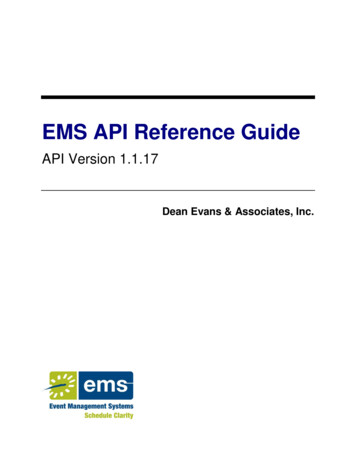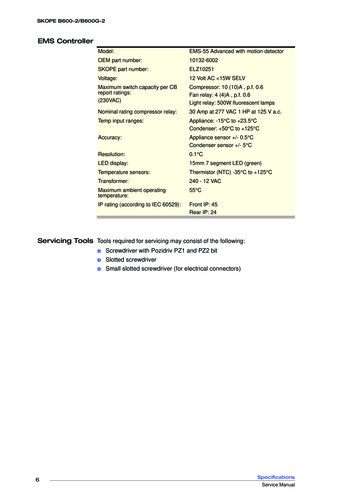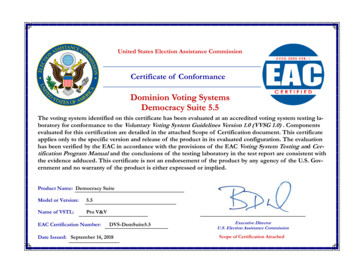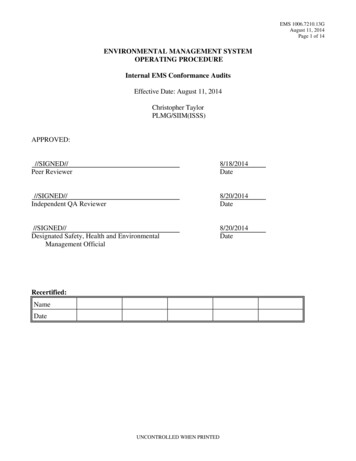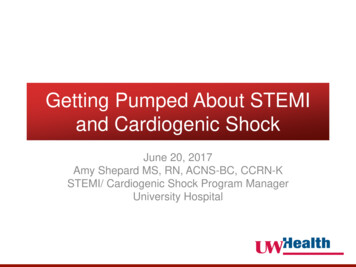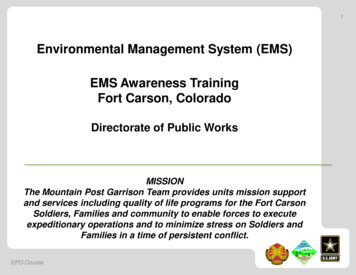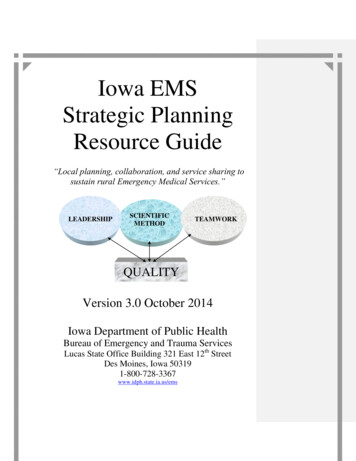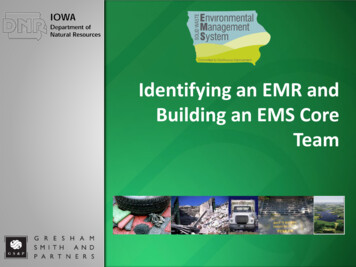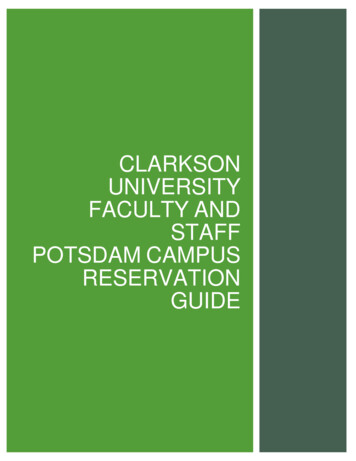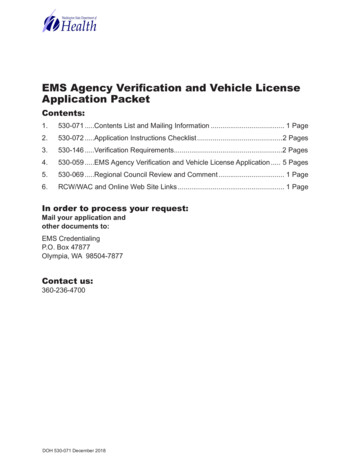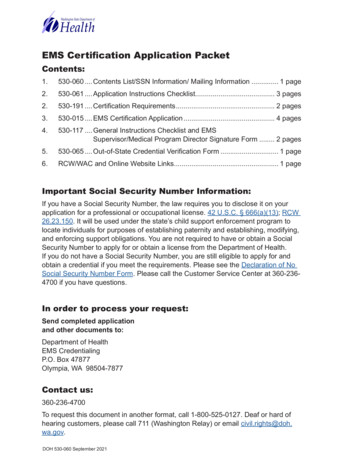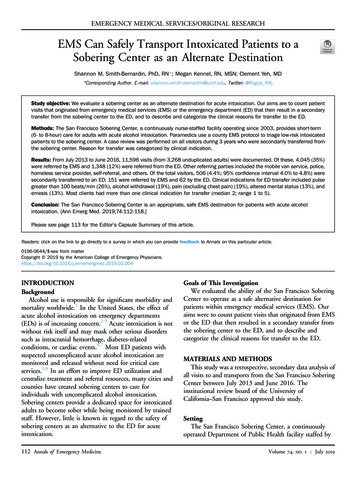
Transcription
EMERGENCY MEDICAL SERVICES/ORIGINAL RESEARCHEMS Can Safely Transport Intoxicated Patients to aSobering Center as an Alternate DestinationShannon M. Smith-Bernardin, PhD, RN*; Megan Kennel, RN, MSN; Clement Yeh, MD*Corresponding Author. E-mail: shannon.smith-bernardin@ucsf.edu, Twitter: @Rogue RN.Study objective: We evaluate a sobering center as an alternate destination for acute intoxication. Our aims are to count patientvisits that originated from emergency medical services (EMS) or the emergency department (ED) that then result in a secondarytransfer from the sobering center to the ED, and to describe and categorize the clinical reasons for transfer to the ED.Methods: The San Francisco Sobering Center, a continuously nurse-staffed facility operating since 2003, provides short-term(6- to 8-hour) care for adults with acute alcohol intoxication. Paramedics use a county EMS protocol to triage low-risk intoxicatedpatients to the sobering center. A case review was performed on all visitors during 3 years who were secondarily transferred fromthe sobering center. Reason for transfer was categorized by clinical indication.Results: From July 2013 to June 2016, 11,596 visits (from 3,268 unduplicated adults) were documented. Of these, 4,045 (35%)were referred by EMS and 1,348 (12%) were referred from the ED. Other referring parties included the mobile van service, police,homeless service provider, self-referral, and others. Of the total visitors, 506 (4.4%; 95% confidence interval 4.0% to 4.8%) weresecondarily transferred to an ED; 151 were referred by EMS and 62 by the ED. Clinical indications for ED transfer included pulsegreater than 100 beats/min (26%), alcohol withdrawal (19%), pain (excluding chest pain) (19%), altered mental status (13%), andemesis (13%). Most clients had more than one clinical indication for transfer (median 2; range 1 to 5).Conclusion: The San Francisco Sobering Center is an appropriate, safe EMS destination for patients with acute alcoholintoxication. [Ann Emerg Med. 2019;74:112-118.]Please see page 113 for the Editor’s Capsule Summary of this article.Readers: click on the link to go directly to a survey in which you can provide feedback to Annals on this particular article.0196-0644/ -see front matterCopyright 2019 by the American College of Emergency 019.02.004INTRODUCTIONBackgroundAlcohol use is responsible for significant morbidity andmortality worldwide.1 In the United States, the effect ofacute alcohol intoxication on emergency departments(EDs) is of increasing concern.2-5 Acute intoxication is notwithout risk itself and may mask other serious disorderssuch as intracranial hemorrhage, diabetes-relatedconditions, or cardiac events.6,7 Most ED patients withsuspected uncomplicated acute alcohol intoxication aremonitored and released without need for critical careservices.3,8 In an effort to improve ED utilization andcentralize treatment and referral resources, many cities andcounties have created sobering centers to care forindividuals with uncomplicated alcohol intoxication.Sobering centers provide a dedicated space for intoxicatedadults to become sober while being monitored by trainedstaff. However, little is known in regard to the safety ofsobering centers as an alternative to the ED for acuteintoxication.112 Annals of Emergency MedicineGoals of This InvestigationWe evaluated the ability of the San Francisco SoberingCenter to operate as a safe alternative destination forpatients within emergency medical services (EMS). Ouraims were to count patient visits that originated from EMSor the ED that then resulted in a secondary transfer fromthe sobering center to the ED, and to describe andcategorize the clinical reasons for transfer to the ED.MATERIALS AND METHODSThis study was a retrospective, secondary data analysis ofall visits to and transports from the San Francisco SoberingCenter between July 2013 and June 2016. Theinstitutional review board of the University ofCalifornia–San Francisco approved this study.SettingThe San Francisco Sobering Center, a continuouslyoperated Department of Public Health facility staffed byVolume 74, no. 1 : July 2019
Smith-Bernardin, Kennel & YehEMS Can Safely Transport Intoxicated Patients to a Sobering CenterEditor’s Capsule SummaryWhat is already known on this topicSobering centers have developed in many cities tocare for uncomplicated alcohol intoxication. Little isknown about their safety.What question this study addressedThe case volume, referrals to the emergencydepartment (ED), and clinical reasons for referralwere recorded and categorized.What this study adds to our knowledgeOf 11,596 sobering center visits, 35% were referredby emergency medical services, 12% by the ED, andsmaller numbers from several other sources. Onepatient was found dead in the sobering centerrestroom from cocaine intoxication. Of the totalsobering center visitors, 506 were secondarilytransferred to an ED for various reasons: tachycardia(26%), alcohol withdrawal (19%), pain (excludingchest pain) (19%), altered mental status (13%), andemesis (13%); there were no deaths.How this is relevant to clinical practiceA sobering center offers a safe and effectivemanagement site for patients with uncomplicatedalcohol intoxication.registered nurses and peer-level support staff, was opened in2003 to provide care for adults aged 18 years and olderwith acute public alcohol intoxication. San Franciscoparamedics use a systemwide county destination protocolfunctioning as an alternative to transporting patientsdirectly to an ED to identify patients who are eligible forevaluation at the sobering center. They follow a triagechecklist to evaluate whether patients with suspectedalcohol intoxication meet low-risk criteria, allowingtransport to the sobering center rather than an ED(Figure 1).In addition, individuals may be referred by police, EDs,health clinics, or street outreach teams, or may self-refer aswalk-in clients. The San Francisco Sobering Center hasdocumented 3,500 to 4,500 visits annually since 2013.With greater than 57,000 client visits since inception, morethan 15,000 individuals were referred directly byparamedics.9The 12-bed facility is colocated with a medical respiteprogram and features nonhospital (standard) beds,accessible showers and toilets, laundry facilities, and aVolume 74, no. 1 : July 2019clinical station with full visibility of all beds (Figure 2).Services are provided by registered nurse and medicalassistant staff using standardized procedures, includingcontinuous and periodic electronic vital sign monitoring,oral rehydration of water and electrolyte solution, meals,activity of daily living support, basic wound care, andvitamin supplements. Referrals to social and medicaldetoxification, urgent care, and shelter are offered for allinterested clients. A social work team consisting of licensedand associate clinical social workers and peer navigatorsprovides advanced care coordination and intensive casemanagement, including referral to psychiatric evaluationand housing.Nursing staff follow protocols that include indications toactivate emergency services in cases in which the patientcondition warrants a higher level of care. These protocolswere initially created by physician and nursing leadershipand undergo biannual audits and review. In addition toobjective measures, including vital sign monitoring, theseprocedures allow for subjective clinical impression andclient request in determining care and discharge options.There is no predetermined minimum or maximum lengthof stay, although a typical client visit lasts 6 to 8 hours.10Selection of ParticipantsSobering center visit information was obtained from theCoordinated Case Management System, an integratedelectronic record system tracking individual-level use acrossmultiple health and welfare systems. Patient visit data wereentered during the provision of care at the sobering center.Adults aged 18 years and older who were admitted to thecenter from July 2013 to June 2016 were included in theanalysis.Methods of MeasurementTwo registered nurses, one doctoral prepared and thesecond masters prepared, and a board-certified emergencyphysician performed a case review on all patient visits thatresulted in a secondary transfer from the sobering center toan ED. In cases in which the initial findings differedbetween reviewers, consensus was reached throughsecondary review and discussion.The 3-person research team conducted 4 meetingsbefore the final case review to discuss common definitionsand parameters of the study. The secondary transfer wascategorized by reasons for transfer (ie, measures of vital signinstability such as abnormal blood pressure, elevated pulse,temperature, seizure activity, chest pain, and death)according to the clinical notes entered by sobering centerstaff. The reasons for transfer are not equivalent in measureAnnals of Emergency Medicine 113
EMS Can Safely Transport Intoxicated Patients to a Sobering CenterSmith-Bernardin, Kennel & Yeh1. DESTINATION INCLUSION CRITERIAa. Sobering Services: Intoxicated pa ents with no acute medical condi on(s) or co-exis ngmedical complaints may be transported to the San Francisco Sobering Center, if thepa ent meets the following criteria:i. Be at least 18 years or older;ii. Found on street / in a shelter or in Police Department custody;b. Voluntarily consent or have presumed consent (when not oriented enough to giveverbal consent) to go to the Sobering Center;c. Not be on the San Francisco Sobering Center “Exclusion List.”*d. Be medically appropriate by mee ng ALL of the following criteria:i. Indica on of alcohol intoxica on (odor of alcoholic beverages on breath, bo lefound on person);ii. Glasgow Coma Score of 13 or greater;iii. Pulse rate greater than 60 and less than 120;iv. Systolic blood pressure greater than 90;v. Diastolic blood pressure less than 110;vi. Respiratory rate greater than 12 and less than 24;vii. Oxygen satura on greater than 89%;viii. Blood glucose level greater than 60 and less than 250;ix. No ac ve bleeding;x. No bruising or hematoma above clavicles;xi. No ac ve seizure; and,xii. No lacera on that has not been treated.*Exclusion List: Periodically, a client may be deemed inappropriate by sobering center stafffor use of the sobering center for a fixed amount of me. The client is then placedtemporarily on an exclusion list. The most common reasons for placement on the exclusionlist are physical violence against staff or other clients and repeated inability to care forbasic needs and ac vi es of daily living once sober. There are typically 3 to 8 persons onthis list at any one me.Figure 1. Criteria for paramedic triage to the San Francisco Sobering Center.to the EMS triage criteria, which provide for a point-intime assessment to achieve an immediate determination foradmission to the sobering center. Discharges or transfersoccur because of nurse evaluation of client conditionduring a longer period and after interventions includingFigure 2. Client dormitory at the San Francisco SoberingCenter.114 Annals of Emergency Medicineoral rehydration, food, rest, use of hygiene facilities, orreview of client medical records.An initial record review was completed to test thestandardized abstraction and comprehensiveness of theclinical criteria evaluated in the study. After initial evaluation,clinical criteria were finalized and the registered nursereviewers independently reviewed 20 charts to train. Astandardized collection form (Excel; version 14.7.3;Microsoft, Redmond, WA) was used for data evaluation.All clinical indications were categorized (Table 1). Manyincidents had more than one clinical indication for EDtransfer. Statistical analyses were performed with Stata/IC(version 14.1; StataCorp, College Station, TX).This study included patient visits to the sobering centerduring 3 fiscal years, from July 2013 to June 2016.RESULTSA total of 11,596 visits (from 3,268 unduplicated patients)were received at the sobering center during the study period.EMS referrals (n¼4,045) were 35% of total visits, and 12%(n¼1,348) were referred from the ED. Other referring partiesVolume 74, no. 1 : July 2019
Smith-Bernardin, Kennel & YehEMS Can Safely Transport Intoxicated Patients to a Sobering CenterTable 1. Clinical indications for secondary transfer from the San Francisco Sobering Center to an ED.Clinical IndicatorRangePulse, unstable, beats/min 100 (high); 60 (low)Blood pressure, unstable, mm Hg 160 systolic or 100 diastolic (high); 100 systolic (low) Temperature, F/ C 100/37.8 (high); 95/35 (low)Respiration, breaths/min 20 (high); 7 (low)SpO2, % 90 (low)Blood glucose level,mg/dL (finger stick) 250 (high); 50 (low)Alcohol withdrawal, suspectedClinical note may include tremors, hallucinations/delusions, headache, nausea, Clinical InstituteWithdrawal Assessment score. Excludes seizure activity.InjuryClinical note includes reference to physical signs of trauma, laceration, abrasion, swelling, or incidence of or clientstatement of injury. Injuries may have occurred on site or before admission to sobering center.FallClinical note indicates client fall on site with or without injury, including fallfrom standing or out of bedPatient complaint of painComplaint of acute pain, excluding chest painChest painIndicates specific complaint of chest pain or discomfortSeizure activityIncludes both witnessed seizures and suspected seizure followed by sudden change inmental status, difficult arousal, incontinence, bleedingAltered mental statusIncludes either a decrease in mental status after admission or a persistent altered statethat has not improved with timeDrugs, otherIncludes client statement of ingestion of other drugs, or corresponding symptoms with orwithout the presence of paraphernalia or other drugsSuicidal ideations or attemptIncludes client statement of intent to harm self, inability to contract for safety, signs of injury,and witnessed attempts at self-harmEmesisIndicates active vomiting as opposed to nauseaClient requestClient request not accompanied with signs of need for higher level of careincluded the mobile van service (n¼2,691; 23%), police(n¼1,020; 9%), homeless service provider (n¼972; 8%),self-referral (n¼836; 7%), and others (n¼685; 6%).The majority of patients were found to have completedcare safely at the sobering center without transfer to theED. Of the 11,596 total visitors, 506 (4.4%; 95%confidence interval [CI] 4.0% to 4.8%) were transferred tothe ED. Of the 4,045 EMS referrals, 151 (3.7%; 95% CI3.1% to 4.3%) visits resulted in a secondary transport tothe ED. Of the 1,348 ED referrals, 62 individuals (4.5%;95% CI 3.4% to 5.6%) returned from the sobering centerto the ED. Referred patients from all other parties(n¼6,203), such as police referrals and walk-ins, had 293transfers by ambulance to an ED, for a transfer rate of 4.7%(95% CI 4.2% to 5.2%).Although most unduplicated patients (n¼142) weretransferred one time, 26 patients had multiple incidentsrequiring transfer to the ED by ambulance (range 2 to 8incidents).Case review identified the most frequent clinicalindications for secondary transfer to the ED for EMSVolume 74, no. 1 : July 2019referrals: elevated pulse, persistent altered mental status notexplained by alcohol intoxication, patient complaint of pain(not including chest pain), signs of alcohol withdrawal, andemesis (Table 2). Greater than 60% of clients had morethan one clinical indication for transfer (median 2; range 1to 5).Length of stay for EMS referrals before secondarytransfer to the ED varied: 38 visits (25%) transporting atless than 1 hour, 42 (28%) between 1 and less than 3hours, 25 (17%) at 3 to less than 6 hours, and 47 (31%)occurring after a 6-hour stay.Secondary transfer of clients initially referred from theED to the sobering center who subsequently returned tothe ED varied slightly from that of those received fromEMS directly: elevated pulse, signs of alcoholwithdrawal, patient complaint of pain (not includingchest pain), elevated blood pressure greater than 160mm Hg systolic or greater than 100 mm Hg diastolic,and chest pain (Table 2). Most clients (77%; median 2;range 1 to 5) had more than one clinical indication fortransfer.Annals of Emergency Medicine 115
EMS Can Safely Transport Intoxicated Patients to a Sobering CenterSmith-Bernardin, Kennel & YehTable 2. Clinical reason for transfer to the ED.EMS Referrals(n[151),No., % (95% CI)ED Referrals(n[62) No., %(95% CI)Clinical Reason for DischargeEMS and ED Combined(n[213, 168 Unduplicated Clients),No., % (95% CI)Pulse high, 100 beats/min56, 26 (21–33)27, 18 (13–25)29, 47 (34–59)Alcohol withdrawal, suspected41, 19 (13–28)19, 13 (8–23)22, 36 (22–58)Complaint of pain40, 19 (14–25)26, 17 (12–24)14, 23 (14–35)Emesis28, 13 (9–18)18, 12 (8–18)10, 16 (9–28)Altered mental status28, 13 (9–18)27, 18 (13–25)1, 2 (0–11)Blood pressure high, 160 systolic, 100 diastolic, mm Hg25, 12 (8–17)12, 8 (5–14)13, 21 (12–33)Client request (no obvious need)25, 12 (8–17)16, 11 (7–17)9, 15 (8–26)Chest pain18, 8 (5–13)6, 4 (2–9)12, 19 (11–31)Seizure16, 8 (5–12)9, 6 (3–11)7, 11 (5–22)Fall15, 7 (4–11)14, 9 (6–15)1, 2 (0–11)Length of stay at the sobering center for ED referralsbefore transfer back to the ED was longer than for EMS: 8(13%) at less than 1 hour, 6 (10%) at 1 to less than 3hours, 18 (29%) at 3 to less than 6 hours, and 30 (48%)transferring after greater than a 6-hour stay.Indications for secondary transfer varied between EMSand ED referral sources. ED referrals (n¼62) comparedwith EMS referrals (n¼151) resulted in higher rates oftransfer for alcohol withdrawal (36%, 95% CI 22% to58% versus 13%, 95% CI 8% to 23%) and elevated bloodpressure (21%, 95% CI 12% to 33% versus 8%, 95% CI5% to 14%).One death occurred during the study period. A 62year-old man admitted through EMS at 10:30 PM was foundunconscious in the restroom approximately 3 hours afteradmission. A glass pipe and white powder were present. EMSwas unsuccessful in reviving the patient. The death certificatecause of death was cocaine intoxication. Peripheral bloodanalysis contained cocaethylene, cocaine at 0.05 mg/L, andbenzoylecgonine at 0.48 mg/L, with cocaine and metabolitesconfirmed in the urine sample as well. No acute fataltraumatic injuries were noted.LIMITATIONSAs noted previously, the sobering center admissioncriteria and the clinical indicators for secondary transfer donot coincide exactly, and discharge or transfer decisions areoften based on assessments conducted during a certainperiod. A prominent limitation is the reliance on clinicaljudgment and staff experience in initiating a secondarytransfer of a patient. Despite protocols and guidelines, thereare few medical scenarios dictating immediate 911 response(eg, chest pain, fall with head trauma), and thus transferdecisions may be based on presentation, including116 Annals of Emergency Medicinesubjective information. Additionally, a client determinedby sobering center staff to require ED care may refusetransport and thus not be discharged by ambulance. Thesecases would not have been captured in this study.We do not have the final hospital outcomes for thisstudy. The standard practice is that any receiving party(such as a medical or psychiatric ED) will contact thesobering center management for any negative outcomesreceived by an ED in transfer. Additionally, the soberingcenter is connected to the countywide Unusual Occurrenceonline reporting system, which is used by all staff for anynegative client outcomes at all county health facilities,including the county hospital and clinics. Any severenegative outcomes (hemorrhage, death, etc) and safetyconcerns would be reported to this system and investigatedby health officials. In addition, all deaths occurring withinthe county are reported to the Department of PublicHealth. These reports include all services with which thedeceased had contact before death. For any deaths within 30days of discharge from the sobering center (and likefacilities), management is contacted and a formal review isconducted.This study is not an evaluation of the triage criteria or acomparison to clients who were determined not eligible forsobering center care. Admission is based on presumedintoxication on alcohol; however, there are no definitivescreening tools used (such as a breathalyzer) to confirmalcohol consumption. Clients may have incidentalintoxication with other drugs or medications that wouldaffect their risk for transfer to the ED.DISCUSSIONThis study evaluated the ability of the sobering center tooperate as a safe alternative EMS destination. The majorityVolume 74, no. 1 : July 2019
Smith-Bernardin, Kennel & YehEMS Can Safely Transport Intoxicated Patients to a Sobering Centerof patients did not require acute care in an ED. Patientswho did develop a concerning health condition such asabnormal vital signs, complaints of pain, or altered mentalstatus were transferred to the ED. There were no notedcases of low blood glucose level, stroke, intracranialhemorrhage, or injuries related to violence within thesobering environment. However, the incident involvingfatal cocaine overdose raises issues surrounding monitoringof clients with the potential for ongoing substance usewhile in the center.A goal of sobering centers is to prevent unnecessaryvisits to the ED by caring for individuals withuncomplicated acute intoxication who do not require EDlevel services.10-14 The majority of sobering center visitsdid not require ambulance discharge, with less than 5%of individuals transferred to a higher level of care. Thissupports previous survey data indicating that protocolbased triage can identify patients appropriate for thistype of care.12However, alcohol intoxication is not without risk fromboth unrecognized medical complications anddecompensation (eg, hemorrhage, hypoglycemia) orintoxication itself (eg, aspiration, trauma from falls, selfharm).1 Initial triage and ongoing monitoring are critical toensuring patient safety.15,16 A recent study found that only1% of patients triaged by emergency physicians to an“intoxication unit” in the ED, dedicated to patients withsuspected uncomplicated alcohol intoxication, requiredcritical care services before discharge.8 Triage by physicianscannot be compared with that performed by paramedicsand registered nurses; however, this study speaks to thenumber of ED patients presenting with uncomplicatedalcohol intoxication who could be cared for in a lesscomprehensive environment.Triage studies have previously found that paramedicevaluation in the out-of-hospital environment cansuccessfully triage individuals with suspected alcoholintoxication to a sobering center environment versus anED.17-20 A common discussion is the sensitivity andspecificity of triage criteria. In studies by Ross et al17 andCornwall et al,18 the sensitivity was high (99% and 93%,respectively); however, overtriage to the ED was evident bythe specificity (42% and 40%, respectively). However, thetiming of the discharge from a sobering center to the EDraises the question of whether these were missed diagnosesor emerging medical conditions within a population withcomplicated disease. Our evaluation lends support to theimportant role of paramedic evaluation in determiningmedical need of individuals with acute intoxication, and theongoing monitoring by registered nurse staff in identifyingemerging medical conditions.Volume 74, no. 1 : July 2019We found that patients transferred to the sobering centerafter being medically cleared in the ED had slightly higherrates of discharge back to the ED. Considering the effects oflong-term alcohol use, including unstable vital signs andalcohol withdrawal, this difference may be related to longerlengths of stay in light of the combination of the ED visit,transport, and sobering center visit, as well as the underlyinghigher-risk population. Additional evaluation is warranted,including length of stay in the ED before sobering centertransfer, before further interpretation of this finding.Our results indicate that the sobering center withregistered nurse staffing is an appropriate, safe alternatedestination for the EMS system in the triage and care ofacute alcohol intoxication. A majority of referrals wereappropriate for the level of support provided, and thesepatients did not require transfer to the ED.Supervising editor: Richard C. Dart, MD, PhD. Specific detailedinformation about possible conflict of interest for individual editorsis available at https://www.annemergmed.com/editors.Author affiliations: From the School of Nursing (Smith-Bernardin)and Department of Emergency Medicine (Yeh), University ofCalifornia–San Francisco, CA; the San Francisco Department ofPublic Health, San Francisco, CA (Smith-Bernardin, Kennel); andthe Division of Emergency Medical Services, San FranciscoDepartment of Emergency Management, San Francisco, CA (Yeh).Author contributions: All authors conceived of and designed thestudy and analyzed the data. CY completed the institutional reviewboard application and obtained institutional approval. SMS-Bperformed data retrieval and data cleaning. SMS-B drafted theinitial article, and all authors contributed significantly to therevisions. SMS-B takes responsibility for the paper as a whole.All authors attest to meeting the four ICMJE.org authorship criteria:(1) Substantial contributions to the conception or design of thework; or the acquisition, analysis, or interpretation of data for thework; AND (2) Drafting the work or revising it critically for importantintellectual content; AND (3) Final approval of the version to bepublished; AND (4) Agreement to be accountable for all aspects ofthe work in ensuring that questions related to the accuracy orintegrity of any part of the work are appropriately investigated andresolved.Funding and support: By Annals policy, all authors are required todisclose any and all commercial, financial, and other relationshipsin any way related to the subject of this article as per ICMJE conflictof interest guidelines (see www.icmje.org). The authors have statedthat no such relationships exist.Publication dates: Received for publication May 4, 2018.Revisions received October 15, 2018; December 20, 2018, andJanuary 10, 2019. Accepted for publication February 4, 2019.Available online March 27, 2019.Presented at the American College of Emergency PhysiciansScientific Assembly, October 2017, Washington, DC.Annals of Emergency Medicine 117
EMS Can Safely Transport Intoxicated Patients to a Sobering CenterREFERENCES1. World Health Organization. Global Status Report on Alcohol andHealth. 2014. Geneva, Switzerland: World Health Organization; 2014.2. Mullins PM, Mazer-Amirshahi M, Pines JM. Alcohol-related visits to USemergency departments, 2001-2011. Alcohol Alcohol.2016;52:119-125.3. Pletcher MJ, Maselli J, Gonzales R. Uncomplicated alcohol intoxicationin the emergency department: an analysis of the National HospitalAmbulatory Medical Care Survey. Am J Med. 2004;117:863-867.4. Verelst S, Moonen PJ, Desruelles D, et al. Emergency department visitsdue to alcohol intoxication: characteristics of patients and impact onthe emergency room. Alcohol Alcohol. 2012;47:433-438.5. Klein LR, Martel ML, Driver BE, et al. Emergency department frequentusers for acute alcohol intoxication. West J Emerg Med. 2018;19:398-402.6. Vonghia L, Leggio L, Ferrulli A, et al. Acute alcohol intoxication. Eur JIntern Med. 2008;19:561-567.7. National Institutes of Health. Alcohol-related emergency departmentvisits and hospitalizations and their co-occurring drug-related, mentalhealth, and injury conditions in the United States. Bethesda, MD:National Institute on Alcohol Abuse and Alcoholism; 2013.8. Klein LR, Cole JB, Driver BE, et al. Unsuspected critical illness amongemergency department patients presenting for acute alcoholintoxication. Ann Emerg Med. 2018;71:279-288.9. Smith-Bernardin SM, Kennel M. Sobering centers: nurse leadership inpre-hospital intervention. Voice of Nursing Leadership. 2018;16:20-22.10. Smith-Bernardin SM, Schneidermann M. Safe sobering: SanFrancisco’s approach to chronic public inebriation. J Health Care PoorUnderserved. 2012;23(3 suppl):265-270.Smith-Bernardin, Kennel & Yeh11. Smith-Bernardin SM, Carrico A, Max W, et al. Utilization of a soberingcenter for acute alcohol intoxication. Acad Emerg Med.2017;24:1060-1071.12. Warren O, Smith-Bernardin SM, Jamieson K, et al. Identification andpractice patterns of sobering centers in the United States. J HealthCare Poor Underserved. 2016;27:1843-1857.13. Castro-Marin F, Maher SA, Navarro T, et al. Impact of a mass gatheringalcohol sobering facility on emergency resources. Prehosp EmergCare. 2018;22:326-331.14. Irving A, Goodacre S, Blake J, et al. Managing alcohol-relatedattendances in emergency care: can diversion to bespoke serviceslessen the burden? Emerg Med J. 2018;35:79-82.15. Wolf L. Considerations in triage for the intoxicated patient. J EmergNurs. 2008;34:272-273.16. Volz TM, Boyer KS. The development of a behaviorally-based alcoholintoxication scale. J Emerg Nurs. 2014;40:330-335.17. Ross DW, Schullek JR, Homan MB. EMS triage and transport ofintoxicated individuals to a detoxification facility instead of anemergency department. Ann Emerg Med. 2013;61:175-184.18. Cornwall AH, Zaller N, Warren O, et al. A pilot study of emergencymedical technicians’ field assessment of intoxicated patients’ need forED care. Am J Emerg Med. 2012;30:1224-1228.19. Flower K, Post A, Sussman J, et al. Validation of triage criteria fordeciding which apparently inebriated persons require emergencydepartment care. Emerg Med J. 2011;28:579-584.20. Swain AH, Weaver A, Gray AJ, et al. Ambulance triage and treatmentzones at major rugby events in Wellington, New Zealand: a soberingexperience. N Z Med J. 2013;126:12-24.What Review Topics do you want to read in Annals? We are seeking your favorite topics forclinical review articles (and suggestions for expert auth
INTRODUCTION Background Alcohol use is responsible for significant morbidity and mortality worldwide.1In the United States, the effect of acute alcohol intoxication on emergency departments (EDs) is of increasing concern.2-5Acute intoxication is not without risk itself and may mask other serious disorders such as intracranial hemorrhage, diabet.
